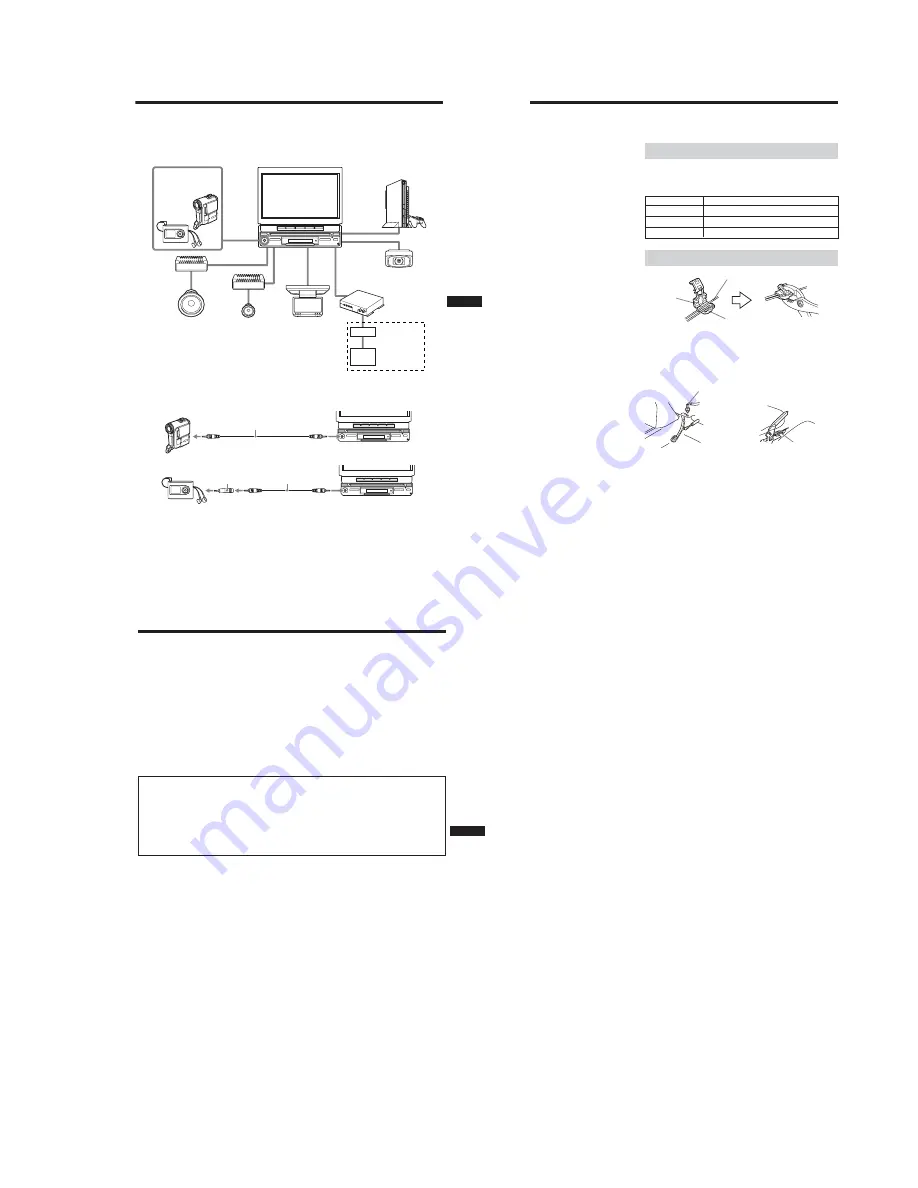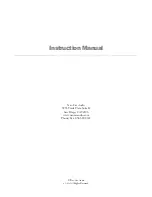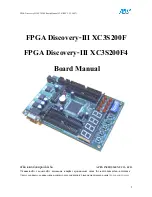
9
XAV-C1
5
Connection Example
For details, see the section “
1
Car Systems Connections” (pages 7 - 10). Be sure to refer also to the
documentation for all other components in the system.
System configuration
* Connect with supplied connecting cable
3
. (Use a conversion plug
4
when you connect the audio equipment.)
When you connect the video camera
3
When you connect the audio player
3
4
Notes
• Be sure to connect the ground cord before connecting the amplifier.
• If you connect an optional power amplifier and do not use the built-in amplifier, the beep sound will be deactivated.
Walkman or
Video Camera
(optional)
AV Center XAV-C1
Game (optional)
A/V IN*
(Front)
(AUX 1)
AUX 2
AUX 3
SUB OUT
(MONO)
FRONT L/R
REAR L/R
REAR
MONITOR
OUT
AUX 3 and BUS
Back Camera
(optional)
Amplifier
(optional)
Amplifier
(optional)
Subwoofer
(optional)
Speaker
(optional)
Rear Monitor
(optional)
TV Tuner XT-V70
(optional)
XM Radio Tuner
(optional)
Connection Box
XA-123
(US, Canadian)
6
Connecting the cords
Connect each cord using the taps. For the combination of each
cord, see the following table. Also, see the section “
1
Car
Systems Connections” (next page).
Using the tap
Connecting the parking cord
The mounting position of the parking brake switch cord depends
on your car. Refer to the system connection illustrations below
and consult your car dealer or your nearest Sony dealer for
further details.
Foot brake type
Hand brake type
The cord for utilizing the back camera better
Purple/white cord (for the connection to the power terminal
cord of the back lamp)
If you connect the purple/white cord to the power terminal cord
of the back lamp, the image of back camera will be automatically
displayed on the monitor when a back lamp lights up. You can
adjust the parking location viewing the image of back camera
when you backup.
Parking brake
switch cord
Connecting Information
For details, see the section “
1
Car Systems Connections” (next page).
Notes
• Be sure to connect the power input
cord after all other cords are connected.
• If the parking brake switch cord is too
thin, connect the parking cord to the
parking brake switch cord directly
without using the tap.
Parking brake switch cord
Tap
9
Parking cord
(Light green)
Main unit side
Car side
Orange/white
Illumination signal cord
Purple/white
Power terminal cord of the back lamp
Light green
Parking brake switch cord
Parking brake
switch cord
7
1
Car Systems Connections
Refer also to the documentation for all other components in the system.
Also see “Connecting Information” on page 6.
• Components listed here except for supplied accessories are available separately. When connecting such
components, be sure to also refer to their documentation.
For specifications and other information on separately available components, contact your dealer.
Prevention of accidents caused by short-circuits
To prevent the risk of accidents caused by short-circuits, connect the power supply leads (red and yellow)
only after all other wiring has been completed, and only with the ignition key in the OFF position.
Otherwise, accidental short-circuiting can lead to electric shock and to serious damage.
When a fuse has blown,
check the wiring and locate the cause of the problem before replacing the fuse.
When replacing the fuse, be sure to use only a fuse of the same rating (ampere rating). Using a different
fuse or bridging the contacts with wire is highly dangerous and can lead to serious damage.
Make sure to connect all of the following leads.
Otherwise there is a risk of electric shock, damage to the equipment, or malfunction.
• Connect purple/white lead to back lamp lead of car.
• Connect orange/white lead to illumination signal lead of car.
• Connect light green lead to parking brake switch lead of car.
• Connect yellow lead to battery power supply of car.
• Connect red lead to accessory power supply of car.
• Connect black lead to metal point on car chassis.
*
Do not mix up the yellow and red leads, as this will cause the memory contents to be lost.
Observe the following precautions.
Otherwise there is a risk of electric shock, damage to the equipment, or malfunction.
• Cover unused connectors with electrician’s tape to prevent accidental contact.
• Route FM/AM antenna cable, bus cable, RCA interconnects, and power supply leads as far apart from
each other as possible, to prevent noise interference.
• Always grasp the connector and do not pull the cable when disconnecting the bus cable or other cables.
Otherwise the cable may become detached.
Notes on the control and power supply leads
• The power antenna control lead (blue) su12 V DC when turn on the tuner.
• When your car has built-in FM / AM antenna in the rear / side glass, connect the power antenna
control lead (blue) or the accessory power input lead (red) to the power terminal of the existing
antenna booster. For details, consult your dealer.
• A power antenna without relay box cannot be used with this unit.
Memory hold connection
When the yellow power input lead is connected, power will always be supplied to the memory circuit
even when the ignition key is turned off.
8
Notes on speaker connection
• Before connecting the speakers, turn the unit off.
• Use speakers with an impedance of 4 to 8 ohms, and with adequate power handling capacities to avoid
its damage.
• Do not connect the speaker terminals to the car chassis, or connect the terminals of the right speakers
with those of the left speaker.
• Do not connect the ground lead of this unit to the negative
E
terminal of the speaker.
• Do not attempt to connect the speakers in parallel.
• Connect only passive speakers. Connecting active speakers (with built-in amplifiers) to the speaker
terminals may damage the unit.
• To avoid a malfunction, do not use the built-in speaker wires installed in your car if the unit shares a
common negative
E
lead for the right and left speakers.
• Do not connect the unit’s speaker cords to each other.










































